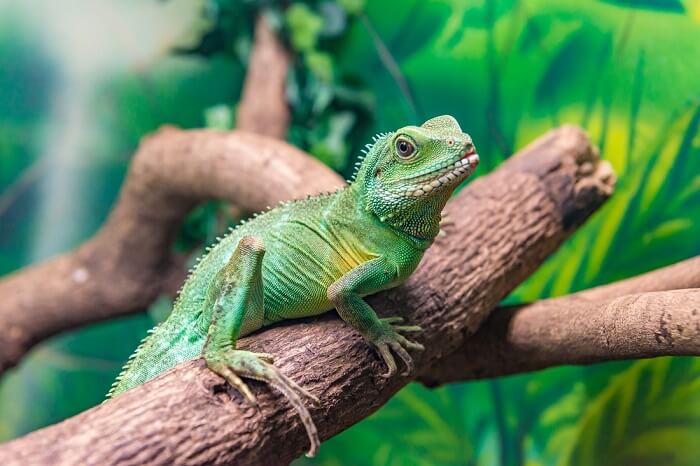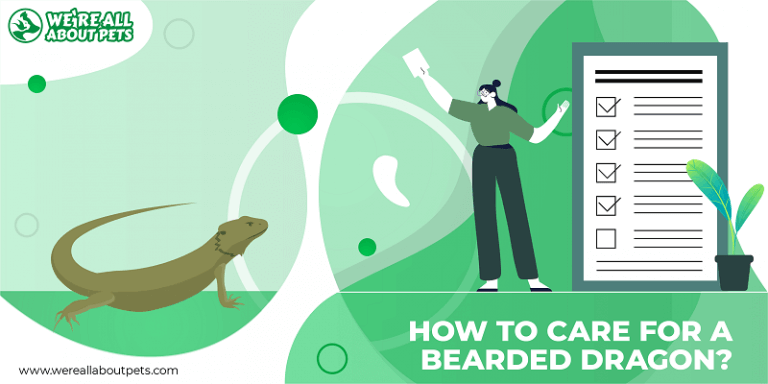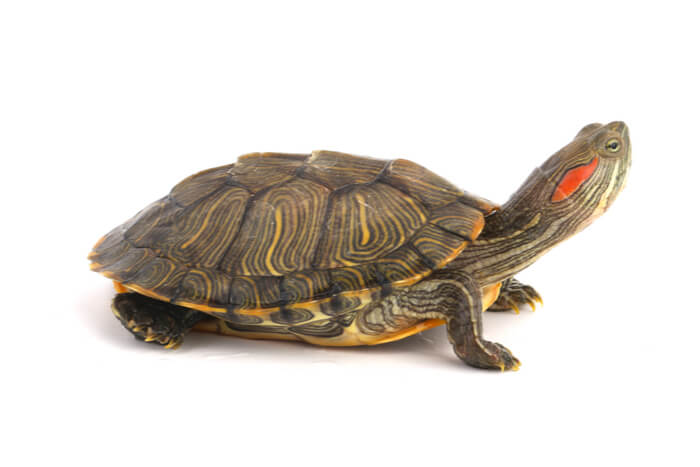Caring For A Box Turtle: The Ultimate Guide
This page contains affiliate links. We may earn money or products from the companies mentioned in this post through our independently chosen links, which earn us a commission. Learn More
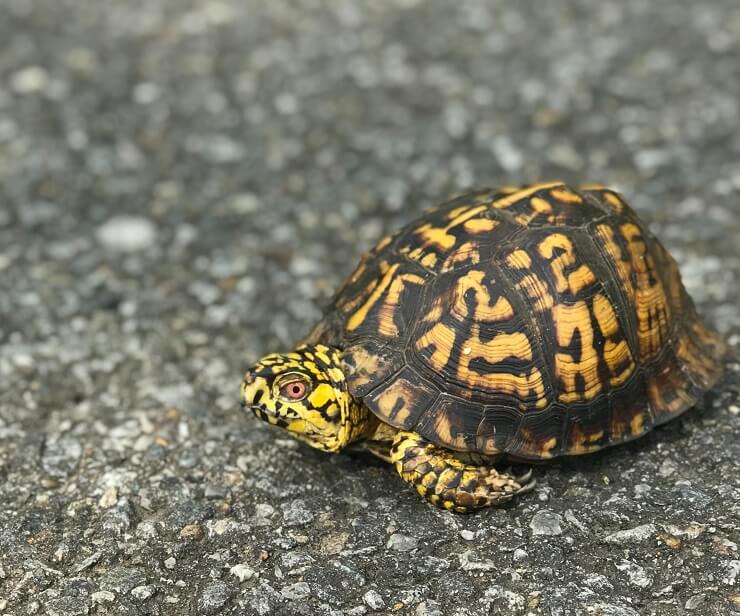
Box turtles can make good pets and offer unique traits that make them fun to be around. They have a cool domed shape and a lower shell that closes fully. The male Eastern Box Turtles have red eyes that give them a blast of color! This article will help you understand their special needs and decide if they’re the right pet for you.
Care
Care of a reptile includes providing the right enclosure. It needs the proper temperature, lighting, humidity, substrate and size. Box turtles can live 40-50 years in captivity, and some reports suggest that they can live more than 100 years with good care.
Cage Size
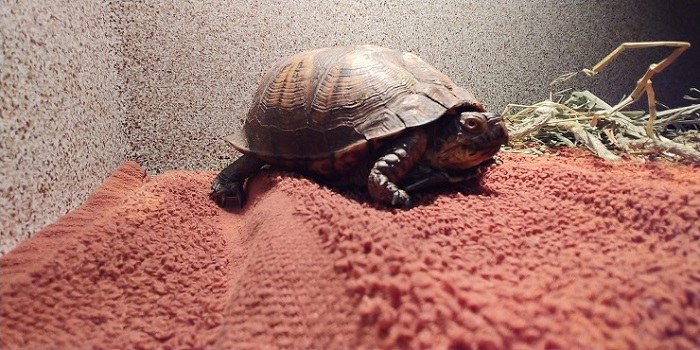
Box turtles grow to be only 300-600 grams as adults, but they do need plenty of room to move around and explore. Keep that in mind for the long-term plans. While a 10-gallon aquarium may be fine for a juvenile, your adult turtle will need a larger enclosure. For an adult, it’s recommended that the enclosure be 2 x 4 feet.
The sides should be 9-12 inches above the substrate to prevent escape. If you have other pets in your home, then the enclosure needs to be covered or placed in an area that prevents a cat or dog from getting to your turtle. A dog may think of the turtle as a toy and cause severe trauma with play.
In the right climate, box turtles can have an outdoor enclosure, but generally the outdoor area should be for supervised outdoor time. They can be supervised in a normal yard as long as there are no fertilizers, pesticides or other chemicals sprayed on the lawn.
Substrate
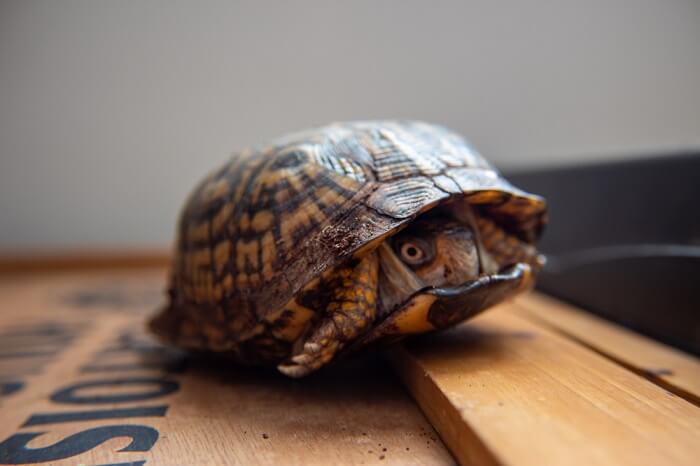
Both indoor and outdoor enclosures should have a substrate that allows some burrowing behaviors. Several inches of sterile potting soil or coconut fiber are recommended. Cypress or aspen wood chips can also be added for a texture variety. Avoid pine and cedar since they have irritating oils that may contribute to respiratory irritation. Some leafy material helps provide enrichment and closely matches their native areas. In our other article, you can learn more about appropriate substrates.
In addition to the soil and fiber, some type of hides should be provided on both the hot and cool end of the enclosure. Many cages have a built-in hide on one side. Half logs can also be utilized well. Flat rocks in the enclosure help them keep their nails short and provide an area to provide food while minimizing the chance of ingesting other substrates.
Temperature

Enclosures should have a temperature range between 75 and 80 F, with a basking area that stays between 85-90F. A powerful heat lamp or ceramic heater can provide the needed heat source. Make sure that the lamp is above the level that would allow direct contact. For enclosures with multiple animals, provide several basking areas. Overnight the temperature can drop to 70F.
For any supervised outdoor times, make sure there is plenty of shade and avoid the hottest time of the day. These turtles normally live in forested areas with plenty of protection from the direct sun.
Lighting
Like most reptiles, box turtles need access to UVB lighting to make Vitamin D3 and utilize calcium properly. A UV light must be provided for 12 hours a day. Be aware that the UV spectrum wanes long before the light burns out, so it should be replaced every 6 months.
Supervised outdoor time is helpful for supplementing the need for UVB, since the sun is far more effective than any of the commercial UV bulbs available. Reference: Selleri P and DiGirolamo N. Plasma 25-hydroxyvitamin D3 concentrations in Hermann’s tortoises (Testudio hermanni) exposed to natural sunlight and two ultraviolet radiation sources. AJVR 73(11): 1781-86.
There’s some evidence that the day-night cycle may need to change through the year for ideal health. That makes sense when you realize that the native habitat of Eastern box turtles extends as far north as Massachusetts, where there’s a huge difference in day length from summer to winter.
Humidity

Box turtles include several subspecies that are all native to North America. The range includes temperate forest and meadowland. The humidity in the enclosure should be moderately high: 40-55%.
Indoors, use a hygrometer to make sure that the required humidity is provided. They should have humid hides filled with moss that’s regularly changed to avoid the growth of mold. The Smithsonian Zoo has good information about their habitat and conservation. For further reading, click here.
Temperament
Box turtles are generally gentle animals, but they don’t like to be handled. That should be a consideration in a decision to adopt one of these animals. If you’re looking for an interactive pet or for a pet for a child, it may not be the best choice. Handling will stress them and may affect their health, though when handled, biting is extremely rare.
Diet
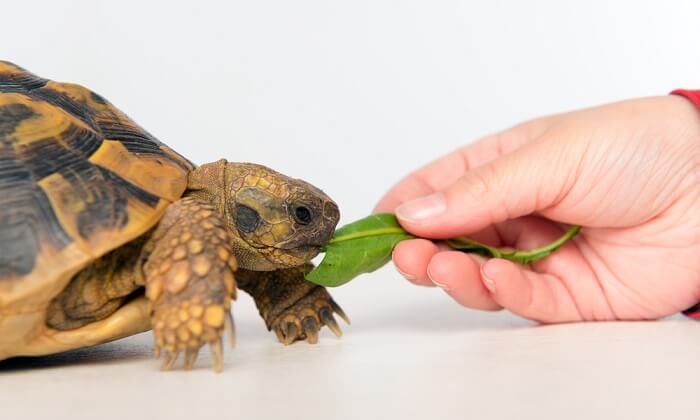
Box turtles are omnivores, so they will eat both vegetables and they’ll opportunistically eat insect prey. Realize that with 6 common subspecies, there are some differences, so be sure to research specifics for your turtle and discuss recommendations with your veterinarian.
They should never be given foods designed for other animals. Dog and cat food has a good deal of animal protein at levels that they can’t digest effectively. High levels of animal protein is very hard on their kidneys and will lead to early kidney failure.
Salads can be offered daily. Vegetables that are good for the salads include a base of Romaine lettuce, red-or-green leafed lettuce, spring mix, hibiscus, or dandelion greens. The occasional addition of collard greens, carrot tops, kale, and mustard greens are fine provided they are done more as treats. You can add other vegetables for variety: carrots, cactus pads, cucumber, bell pepper, butternut squash (steamed) and bok choy are all good choices.
Occasional treats of fruits can be offered. They should be offered less often than the vegetables and in smaller servings because the sugar content isn’t good for their digestion. Most tend to enjoy strawberries, tomatoes, cantaloupe, blueberries and hibiscus flowers.
Occasional earthworms, slugs, or snails can make up 5-10% of the diet. Make sure to get them from a source free of pesticide exposure.
All insect prey should always be supplemented with calcium. Picky eaters should also have vitamin supplements 1-2 times per week as well. Make sure the vitamin has pre-formed vitamin A rather than beta carotene. Box turtles may be unable to convert beta carotene to vitamin A as you and I do.
Water should be available in the enclosure and should be cleaned and replaced daily. It should be deep enough and large enough to allow soaking, but shallow enough to give easy entry and exit. About 1/3 the depth of their shell is a good rule-of-thumb. The bowl needs to allow easy entry and exit.
Health Concerns
Tortoises should be seen regularly by a veterinarian. The most common health concerns that you may see include:
- Respiratory infections
- Beak deformities
- Nutritional deficiencies
- Trauma (animals)
- Abscesses
- Skin and shell diseases, including bacterial and fungal infections
- Shell damage
- Parasites
It’s also good to get an annual health exam for your tortoise. If you need to find an experienced reptile veterinarian, start your search here.
Summary
Box turtles have a great temperament and can be a great pet for someone willing to make the commitment to the care they require, with a relatively small-sized enclosure. Need help naming your new friend? See this article for suggestions.
Frequently Asked Questions
Why is it illegal to have a box turtle?
Most subspecies of box turtles are endangered due to habitat loss, capture for the pet trade and global climate change. Because of concern for their well-being, it’s illegal to have wild caught box turtles. In some states it’s also illegal to have captive bred turtles as well, so be sure to research the local laws in your area.
Can you keep a box turtle as a pet?
So long as you find a captive-bred turtle and keep it with the proper permits or in a state that doesn’t have laws against owning them, then you can. It’s just important to be sure that you can commit to good care for a lifetime.
Do box turtles like to be held?
No. Handling them excessively will cause them stress that may affect their health in the long term.
Will box turtles die if you move them?
They can be safely moved but try to minimize handling when possible. They can be moved to new homes, and they can be moved from their enclosures for cleaning or supervised outdoor time. They just don’t appreciate cuddling or playing.






